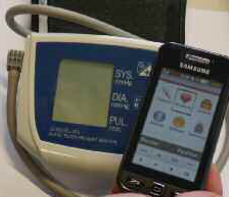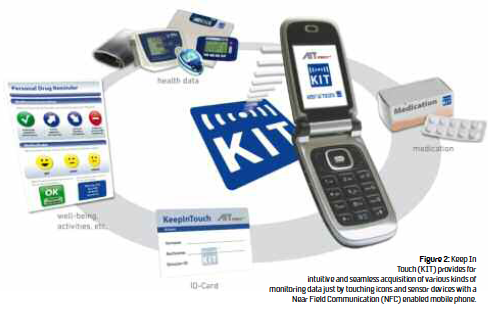By Günter Schreier & Peter Kastner
The management of patients with chronic diseases in general and diabetes mellitus, in particular, requires a dedicated infrastructure to support patients and doctors in communication and intensive collaboration, without the need for frequent face-to-face meetings. Pervasive healthcare is a term that draws on mobile communication devices and the Internet as well as concepts like ubiquitous computing and ambient intelligence. The term “mHealth” is being more and more commonly used to encompass these ideas of patient-centered, prevention-oriented, and decentralized health management and treatment of chronic conditions using mobile and wireless communication technologies.
During the last decade the eHealth & Ambient Assisted Living team of the Austrian Institute of Technology (AIT) has developed and evaluated a variety of mHealth solutions for people with chronic conditions, among them patients with:
- Metabolic diseases (diabetes, obesity)
- Cardiovascular diseases (chronic heart failure, hypertension, pulmonary arterial hypertension)
- Dermatological diseases (psoriasis)
and, in general, also for elderly people that need assistive technologies, e.g., to improve medication compliance. About a year ago we started with a proof-of-concept telediabetes project in collaboration with the Austrian Insurance Institution for Railways and Mining Industry. In the course of this project diabetes patients are equipped with a mobile phone-based telemedicine system based on the Keep In Touch (KIT) technology. KIT is a concept for intuitive human computer interfacing that uses smart objects and wireless technologies like Near Field Communication (NFC) and Radio Frequency Identification (RFID). KIT enables people to collect information from health-related items of their daily life by simply touching those things with their NFCenabled mobile phones.

Figure 1: A patient transmits his recently measured blood pressure values
simply by bringing his Near Field Communication (NFC) enabled mobile
phone close to the NFC enabled blood pressure device (UA 767 plus
NFC, A&D Company, Tokyo, Japan).
Patients are equipped with NFC-enabled mobile phones with a pre-installed diabetes application and a varying set of medical measurement devices (glucose meter, blood pressure device, weight scales), depending on their disease conditions (type 1 or type 2 diabetes mellitus, type of therapy and medication). A dedicated mHealth service platform provides for mobile phone and Web-based access for patients and doctors and features a diabetes specific electronic patient record, communication via E-mail and Short Message Service (SMS), data storage and processing, and trend curve visualization, as well as support for device management and logistics. The whole system is designated “DiabMemory.”
The project will be subject to an extensive evaluation program. Among the issues to be assessed are various measures of patient compliance. Since May 2010, more than 250 patients have been enrolled in the program. Initial results indicate that most patients stay in the program and do send a high percentage of the measurements as compared to the predefined recording and transmission schedule. This indicates that the concept is well accepted by the patients.
Currently, physicians use the dedicated Web accessible system using their individual credentials. In the future, we will provide them with a more direct access to the system by linking the DiabMemory system to the upcoming Austrian national electronic health record system.
DiabMemory, i.e., the combination of the KIT-based user interface and the underlying Closed Loop Healthcare services, is a step towards pervasive healthcare that allows to not only bridge barriers with respect to space (“anywhere”) and time (“anytime”) but also with respect to “anything.” All relevant items that are important for a given monitoring scenario like sensors (e.g., medical measurement devices) and actuators (e.g., medication blisters and dispensers) become “smart objects” and thus can be a part of the pervasive health and care infrastructure that supports patients and elderly people with various chronic conditions (“anyone”).
Günter Schreier Peter Kastner AIT Austrian Institute of Technology GmbH Austria Guenter.Schreier@ait.ac.at
About Brenda Wiederhold
President of Virtual Reality Medical Institute (VRMI) in Brussels, Belgium.
Executive VP Virtual Reality Medical Center (VRMC), based in San Diego and Los Angeles, California.
CEO of Interactive Media Institute a 501c3 non-profit
Clinical Instructor in Department of Psychiatry at UCSD
Founder of CyberPsychology, CyberTherapy, & Social Networking Conference
Visiting Professor at Catholic University Milan.








